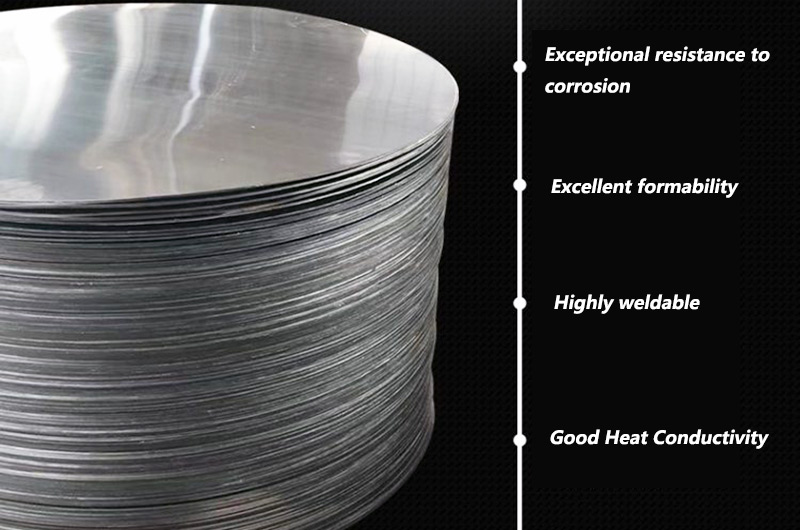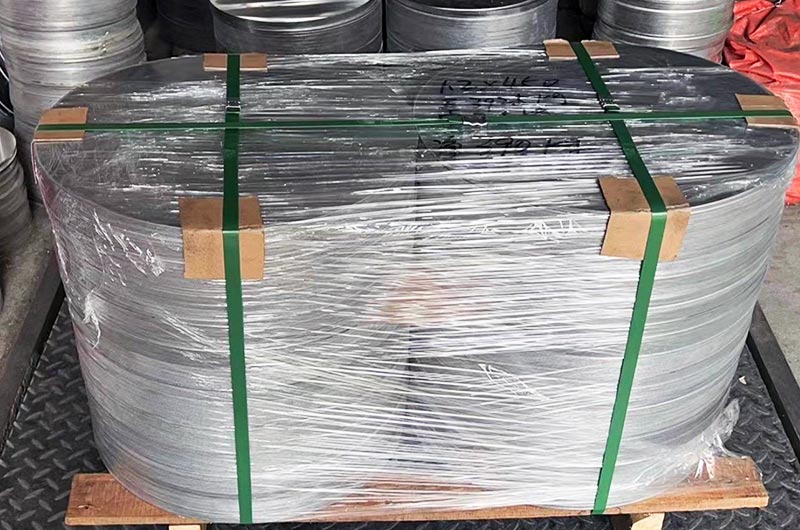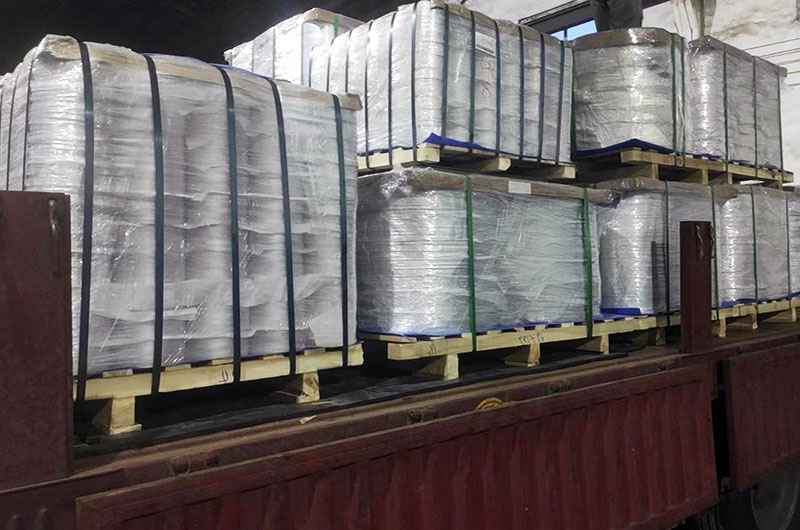- Basic Introduction of 3005 Aluminum Disc Circle
- 3005 Aluminum Disc Circle Specifications
- 3005 Aluminum Disc Circle Typical Temper
- Chemical and Physical Properties
- 3005 Aluminum Disc Circle Surface Treatment
- 3005 Aluminum Disc Circle Advantages and Disadvantages
- 3005 Aluminum Disc Circle Applications
- Other 3000 Series Aluminum Discs
- When to Choose 3005 Aluminum Disc Circle
- Production and Processing Precautions
- 3005 Aluminum Disc Circles Stock
Aluminum is a versatile material with a wide range of applications across various industries, thanks to its unique combination of lightweight properties, corrosion resistance, and ease of processing. Among the many aluminum alloys, the 3000 series is known for its exceptional characteristics.
3005 aluminum is an aluminum alloy with manganese as the main alloying element and magnesium added, making it stronger than 3003 alloy.

Basic Introduction of 3005 Aluminum Disc Circle
3005 Aluminum Disc Circles belong to the 3000 series of aluminum alloys, which are known for their superior corrosion resistance. This particular alloy, 3005, is characterized by its excellent formability and weldability. The term "disc circle" signifies the shape in which this alloy is often manufactured, typically as circular discs. These discs are used in various applications across industries where a combination of formability and resistance to corrosion is required.
3005 Aluminum Disc Circle Specifications
- Temper: HO, H14, H24, H18, H16, H22, H26
- Thickness: 0.5-10mm
- Diameter: 50mm-1200mm
- Standard production: GBT, EN, ASTM, JIS
- Certification: ISO, SGS, BV
- Surface finish: mill, bright, polished, hair line, brush, sand Blast, checkered, embossed, etching, etc
3005 Aluminum Disc Circle Typical Temper
The temper of an aluminum alloy refers to its mechanical properties, specifically its hardness, strength, and formability. For 3005 Aluminum Disc Circles, the commonly used temper is H14.
3005 H14 Aluminum Disc Circle indicates that the aluminum is strain-hardened and partially annealed, resulting in improved strength while maintaining good formability.
3005 H14 Aluminum Disc Circle is well-suited for various applications, especially those that require a balance between strength and formability.
| Alloy | Temper | Thickness(mm) | Tensile Strength(Mpa) | The Yield Strength(Mpa) | elongation(%) | hardness(HV) |
|---|---|---|---|---|---|---|
| 3005 | 0 | >0.2-0.5 | 115-165 | ≥45 | ≥13 | 35-45 |
| >0.5-1.0 | ≥20 | |||||
| >1.0-4.0 | ≥25 | |||||
| H22 | >0.2-0.5 | 145-195 | ≥110 | ≥10 | 40-60 | |
| >0.5-1.0 | ≥15 | |||||
| >1.0-4.0 | ≥15 | |||||
| H24 | >0.2-0.5 | 170-215 | ≥130 | ≥6 | 58-70 | |
| >0.5-1.0 | ≥8 | |||||
| >1.0-4.0 | ≥10 | |||||
| H26 | >0.2-0.5 | 195-240 | ≥160 | ≥3 | 65-83 | |
| >0.5-1.0 | ≥4 | |||||
| >1.0-4.0 | ≥6 | |||||
| H18 | >0.2-0.5 | ≥220 | ≥200 | ≥2 | 80-100 | |
| >0.5-1.0 | ≥3 | |||||
| >1.0-4.0 | ≥3 |
Chemical and Physical Properties
3005 Aluminum Discs Chemical Composition
- Aluminum (Al): 98.0%
- Manganese (Mn): 1.0% - 1.5%
- Iron (Fe): 0.6% max
- Copper (Cu): 0.20% max
- Silicon (Si): 0.3% max
- Magnesium (Mg): 0.20% max
- Zinc (Zn): 0.25% max
- Others: 0.15% max
The chemical composition of 3005 Aluminum Disc Circles plays a crucial role in determining its properties, especially its high resistance to corrosion.
Physical Properties of 3005 Aluminum Discs
- Density: 2.71 g/cm³
- Melting Point: 643°C (1199°F)
- Thermal Conductivity: 173 W/m·K
- Electrical Conductivity: 42-47% IACS
- Coefficient of Thermal Expansion (CTE): 22.0 μm/m·°C

3005 Aluminum Disc Circles possess moderate density, good thermal and electrical conductivity, and a coefficient of thermal expansion suitable for various applications.
3005 Aluminum Disc Circle Surface Treatment
The surface treatment of 3005 Aluminum Disc Circles is an important aspect to enhance its properties and appearance. Common surface treatments include:
1. 3005 Anodized Aluminum Disc Circle
Anodizing forms a protective oxide layer on the surface, further enhancing the already impressive corrosion resistance of 3005 aluminum.
2. 3005 Painted and Coated Aluminum Disc Circle
These discs can be painted or coated with various materials to provide additional protection and achieve specific aesthetic requirements.
3. 3005 Polished Aluminum Disc Circle
Polishing can create a smooth and reflective surface suitable for decorative applications.
3005 Aluminum Disc Circle Advantages and Disadvantages
3005 Aluminum Disc Circles come with their unique set of advantages and disadvantages:
3005 Aluminum Disc Circle Advantages
- Corrosion Resistance: One of the primary advantages of 3005 aluminum is its exceptional resistance to corrosion, making it ideal for applications exposed to harsh environmental conditions.
- Formability: The alloy exhibits excellent formability, allowing it to be easily shaped and processed to meet specific design requirements.
- Weldability: 3005 aluminum is highly weldable, making it suitable for applications where joining is required.
- Lightweight: The low density of aluminum makes it an ideal choice for applications where weight savings are crucial.
- Good Heat Conductivity: While not as high as some other aluminum alloys, 3005 aluminum still provides reasonable thermal conductivity, making it suitable for heat dissipation applications.

3005 Aluminum Disc Circle Disadvantages
- Not as Strong as Some Alloys: 3005 aluminum is not as strong as certain other aluminum alloys, limiting its use in high-stress applications.
- Limited Heat Resistance: While it has good heat conductivity, 3005 aluminum's melting point is relatively low compared to other materials.
- Surface Vulnerability: Untreated 3005 aluminum may not be as resistant to abrasion and wear, requiring surface treatments for protection.
3005 Aluminum Disc Circle Applications
3005 Aluminum Disc Circles find applications in various industries due to their corrosion resistance and formability. Some corresponding applications include:
- Cookware: The alloy is often used in the production of non-stick cookware due to its excellent corrosion resistance and formability.
- Lighting: These discs are utilized in the creation of light fixtures and reflectors, especially in applications exposed to moisture.
- Signage: Road signs, traffic signs, and advertisements benefit from the corrosion-resistant properties of 3005 aluminum.
- Heat Sinks: The alloy is suitable for heat sinks in electronics and other applications where thermal management is important.
- Automotive Parts: 3005 aluminum discs are used in various automotive components, such as hubcaps and decorative trims, where corrosion resistance is necessary.
- Industrial Components: The alloy finds use in industrial components, pressure vessels, and storage tanks due to its ability to withstand harsh industrial environments.
Application Examples
To provide a better understanding of how 3005 Aluminum Disc Circles are used in various industries, here are some real-world examples:
3005 Aluminum Disc Circle for Non-Stick Frying Pans: The base of non-stick frying pans is often made from 3005 Aluminum Disc Circles. They provide excellent heat distribution, corrosion resistance, and a smooth cooking surface.
3005 Aluminum Disc Circle for Reflective Light Fixtures: These discs are commonly used to create reflective surfaces in light fixtures, ensuring efficient light distribution and a durable, corrosion-resistant finish.
3005 Aluminum Disc Circle for Road Signs: Traffic and road signs are frequently manufactured using 3005 aluminum for its corrosion resistance, ensuring that signs remain visible and durable in all weather conditions.
3005 Aluminum Disc Circle for Heat Sinks: 3005 Aluminum Disc Circles are employed in the electronics industry to dissipate heat generated by components like LEDs, transistors, and microprocessors.
3005 Aluminum Disc Circle for Automotive Hubcaps: The lightweight and corrosion-resistant properties of 3005 Aluminum Disc Circles make them ideal for use in automotive hubcaps, ensuring both aesthetics and durability.
Alternatives in Applications
In some cases, alternative aluminum alloys can be used instead of 3005 Aluminum Disc Circles to achieve similar effects. The choice depends on the specific requirements of the application. For example:
- For applications that require even higher corrosion resistance and are not concerned about formability, 5005 or 5052 aluminum alloys can be considered.
- In cases where higher strength is needed, 6061 or 6063 aluminum alloys are alternatives, though they may not provide the same level of corrosion resistance.
For applications where extreme corrosion resistance is necessary, stainless steel can be an alternative, though it will be heavier and potentially more expensive.
In some decorative applications, anodized aluminum can provide a similar corrosion resistance while achieving a variety of aesthetic finishes.
Other 3000 Series Aluminum Discs
The 3000 series of aluminum alloys encompasses a range of alloys, each with its specific properties and applications. Some of the notable members of the 3000 series include:
3003 Aluminum Disc Circle: This alloy is primarily known for its excellent weldability and corrosion resistance. It is commonly used in applications like cooking utensils, heat exchangers, and storage tanks.
3105 Aluminum Disc Circle: 3105 offers a balance between corrosion resistance and strength. It is often used in applications such as decorative trim, gutters, and pressure vessels.
When to Choose 3005 Aluminum Disc Circle
Choosing 3005 Aluminum Disc Circles depends on the specific requirements of your application. Consider selecting 3005 discs when:
1. Corrosion Resistance is a Priority
If your application is exposed to moisture, corrosive elements, or harsh environmental conditions, the exceptional corrosion resistance of 3005 aluminum is a major advantage.
2. Formability is Needed
When your project requires shaping and forming the material to meet specific design requirements, 3005 aluminum's excellent formability makes it a suitable choice.
3. Lightweight Design is Important
In applications where weight savings are crucial, 3005 Aluminum Disc Circles offer the advantage of being lightweight yet corrosion-resistant.
4. Heat Dissipation is Required
While not the highest among aluminum alloys, the reasonable thermal conductivity of 3005 aluminum makes it suitable for applications where heat dissipation is necessary.
5. Welding is Necessary
If your project involves welding or joining, the high weldability of 3005 aluminum is a key benefit.
Production and Processing Precautions
The production and processing of 3005 Aluminum Disc Circles require certain precautions to ensure the highest quality and performance. Some key considerations include:
Surface Preparation: Proper cleaning and preparation of the aluminum surface are essential to ensure effective surface treatments, such as anodizing or painting.
Quality Control: Rigorous quality control measures should be in place to verify the alloy's composition, dimensions, and surface finish.
Heat Treatment: Careful consideration should be given to heat treatments to achieve the desired mechanical properties and temper.
Welding Practices: If welding is involved, use appropriate welding techniques and filler materials suitable for 3005 aluminum to prevent issues like porosity or brittleness.
Surface Treatment Selection: Choose the appropriate surface treatment based on the specific requirements of the application, whether it's corrosion resistance, aesthetics, or heat dissipation.
3005 Aluminum Disc Circles Stock
| Aluminum Disc Circles | Thickness (mm) | Diameter (mm) |
|---|---|---|
| 3005 Aluminum Disc Circles | 0.5 | 150 |
| 3005 Aluminum Disc Circles | 0.5 | 300 |
| 3005 Aluminum Disc Circles | 0.5 | 500 |
| 3005 Aluminum Disc Circles | 0.5 | 1000 |
| 3005 Aluminum Disc Circles | 1.0 | 150 |
| 3005 Aluminum Disc Circles | 1.0 | 300 |
| 3005 Aluminum Disc Circles | 1.0 | 500 |
| 3005 Aluminum Disc Circles | 1.0 | 1000 |
| 3005 Aluminum Disc Circles | 2.0 | 150 |
| 3005 Aluminum Disc Circles | 2.0 | 300 |
| 3005 Aluminum Disc Circles | 2.0 | 500 |
| 3005 Aluminum Disc Circles | 2.0 | 1000 |
| 3005 Aluminum Disc Circles | 3.0 | 150 |
| 3005 Aluminum Disc Circles | 3.0 | 300 |
| 3005 Aluminum Disc Circles | 3.0 | 500 |
| 3005 Aluminum Disc Circles | 3.0 | 1000 |
In summary, 3005 Aluminum Disc Circles are a versatile and corrosion-resistant material suitable for various applications. Their exceptional resistance to corrosion, formability, lightweight design, and weldability make them a preferred choice for projects where these qualities are vital.
By understanding their chemical and physical properties, surface treatment options, common thicknesses and diameters, and real-world applications, you can make informed decisions about when to choose 3005 Aluminum Disc Circles for your specific needs and when to consider alternatives.
